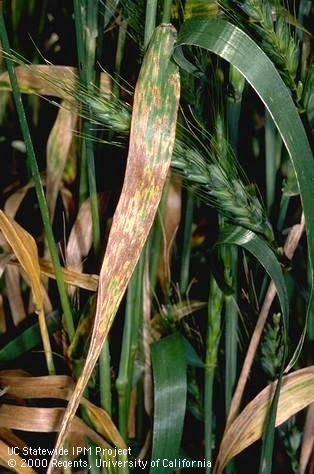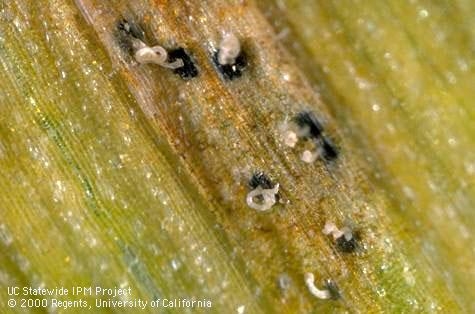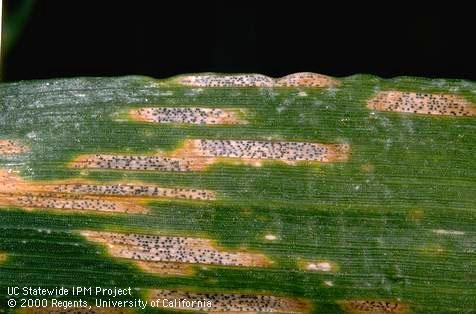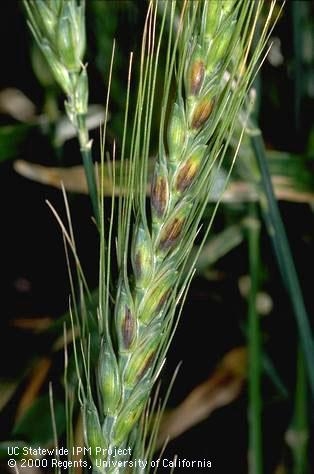
Septoria leaf blotch (also known as septoria tritici blotch, STB) is caused by the fungal pathogen Mycosphaerella graminicola. It is one of the primary diseases in wheat and one that was seen in several locations around the central and southern Sacramento Valley last winter. Growers that observed STB (or other) outbreaks in their wheat last winter should consider management strategies to reduce the severity of outbreaks this coming winter.
100% control of the pathogen is impossible due to the nature of how the pathogen reproduces itself. Infection takes place in two separate stages during the growing season:
1) the initial infection stage, known as the primary infection and
2) the epidemic stage, known as the secondary infection. Primary infection occurs via ascospores, which are windblown spores that can travel long distances. After primary infection occurs, the pathogen will produce pycnidiospores (which look like small black dots on wheat leaves and are visible with a hand lens). Pycnidiospores will exude jelly-like masses packed with conidia when they come in contact with rain or moisture. The conidia are water-dispersed, and will spread throughout the canopy with dew or rain. This is how the infection will continue to spread during the growing season.
The risk of yield loss is greatest when the flag leaf is affected. There are fungicides that can be applied, but they are often not economical, and applications should only be made between tillering and heading. It is too late to control the pathogen this season. But because local (and not just airborne) inoculum has been shown to increase infection rates in the subsequent season, growers have several options to reduce carryover of and infection by M. graminicola inoculum into the next season.

2) Control alternative hosts and volunteer wheat. Because the pathogen is genetically specialized in grasses, and wheat in particular, control of volunteers and certain species of weeds (including bentgrass, common bent, soft brome, soft cheat, barren brome, tall fescue, annual bluegrass, and Kentucky bluegrass) is an important consideration for growers who may be facing higher than average inoculum loads next season. Pay close attention to early flushes of grass species in edges and control volunteer wheat in neighboring fields with in-season herbicide applications can break the link between two seasons and reduce local sources of inoculum.

4) Crop rotation and Controlling Volunteers. Although M. graminicola is an airborne pathogen, several studies indicate some success in suppressing outbreaks by reducing local inoculum loads. As with many soil-borne diseases, crop rotation is an important part of keeping disease levels low. This is because inoculum levels decrease every year without a susceptible host. A 2-year rotation between wheat crops is long enough to reduce M. graminicola inoculum. Broadleaf crops are ideal because grass-specific herbicides can be used to control volunteers. If broadleaf crops are not an option, other grasses can be used because the pathogen is specialized for wheat; the only setback in this case is the fact that grass herbicides targeting wheat volunteers tend to damage other grasses to some extent as well. In either case, volunteer wheat must be controlled for this strategy to work.
5) Seed and foliar fungicidal treatments: STB is not a seedborne disease, but studies have shown that certain fungicidal seed treatments can reduce and delay infections significantly. One study showed that the formation of epidemic-inducing pycnidiospores was reduced by 5 months when triazole fungicide seed treatments were used. Propiconazole is the only major triazole that has been shown to reduce STB and is labeled for wheat in California (trade names: bumper, tide). Foliar treatments, while effective when applied at certain times in the year, are rarely economically justifiable, but seed treatments may offer a more favorable cost:benefit ratio in terms of disease suppression.

Even after wheat has dried out, some pathogens can still be identified by the overwintering structures left on plant material. Growers should feel free to contact their local farm advisors if they are looking for help in identifying signs or symptoms of pathogens in their wheat to make management decisions for the next season.
Primary Reference:
Suffert, F., I. Sache, C. Lannou. (2011). Early Stages of Septoria Tritici Blotch Epidemics of Winter Wheat; Build-up Overseasoning, and Release of Primary Inoculum. Plant Pathology(60), 166-177. doi:10.1111/j.1365-3059.2010.02369.x